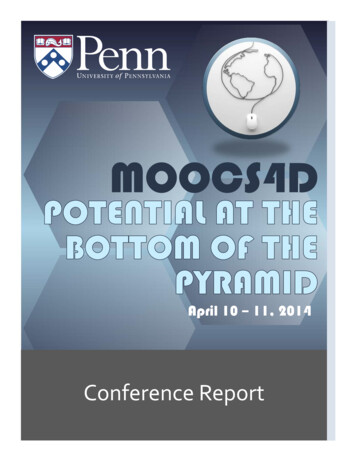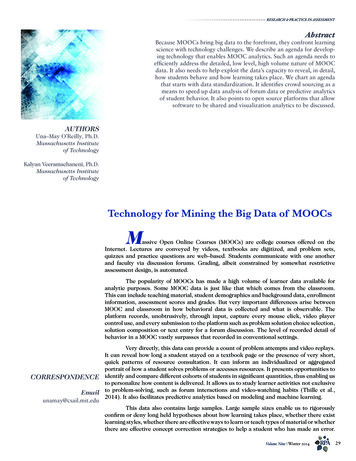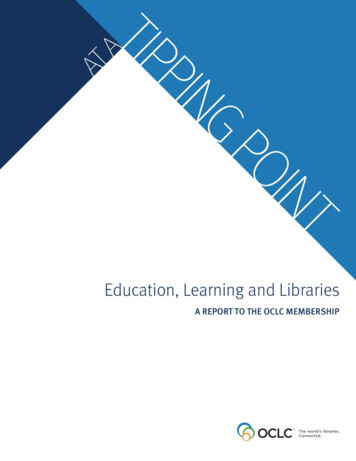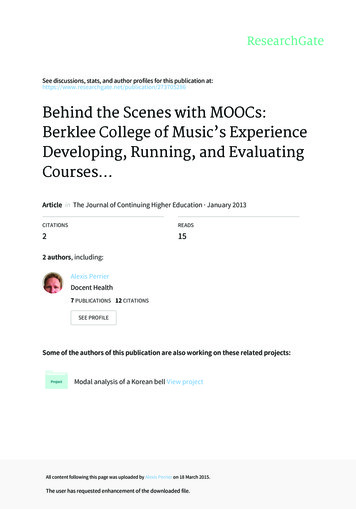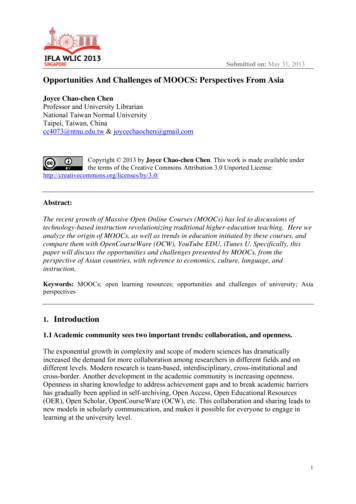
Transcription
Submitted on: May 31, 2013Opportunities And Challenges of MOOCS: Perspectives From AsiaJoyce Chao-chen ChenProfessor and University LibrarianNational Taiwan Normal UniversityTaipei, Taiwan, Chinacc4073@ntnu.edu.tw & joycechaochen@gmail.comCopyright 2013 by Joyce Chao-chen Chen. This work is made available underthe terms of the Creative Commons Attribution 3.0 Unported /Abstract:The recent growth of Massive Open Online Courses (MOOCs) has led to discussions oftechnology-based instruction revolutionizing traditional higher-education teaching. Here weanalyze the origin of MOOCs, as well as trends in education initiated by these courses, andcompare them with OpenCourseWare (OCW), YouTube EDU, iTunes U. Specifically, thispaper will discuss the opportunities and challenges presented by MOOCs, from theperspective of Asian countries, with reference to economics, culture, language, andinstruction.Keywords: MOOCs; open learning resources; opportunities and challenges of university; Asiaperspectives1. Introduction1.1 Academic community sees two important trends: collaboration, and openness.The exponential growth in complexity and scope of modern sciences has dramaticallyincreased the demand for more collaboration among researchers in different fields and ondifferent levels. Modern research is team-based, interdisciplinary, cross-institutional andcross-border. Another development in the academic community is increasing openness.Openness in sharing knowledge to address achievement gaps and to break academic barriershas gradually been applied in self-archiving, Open Access, Open Educational Resources(OER), Open Scholar, OpenCourseWare (OCW), etc. This collaboration and sharing leads tonew models in scholarly communication, and makes it possible for everyone to engage inlearning at the university level.1
1.2 Open digital learning resourcesDigital learning has become an important mode of university instruction. For bothsynchronous and asynchronous learning, the main target includes registered and fee-payingstudents. In 2001, when Massachusetts Institute of Technology (MIT) launchedOpenCourseWare with the hope of making learning resources freely accessible via Internet, ithas become a model followed by global counterparts. Aside from OCW, there are alsoYouTube EDU, iTunes U iTunes U, and other platforms such as UdaCity and Coursera. Thefollowing is the recent development of these platforms.a. OCWThis service was first put forth by MIT in April 2001 (Massachusetts Institute of Technology,2001). As in Oct 2012, MIT offered more than 2,150 online courses, with more than 18.6million visits to the site in 2011, an average of almost 2 million page requests per day, and atotal of 125 million individuals worldwide accessing contents of the site since 2001(Massachusetts Institute of Technology, 2012).b. YouTube EDUYouTube EDU is a section of youtube.com dedicated to educational videos developed bycolleges and universities, including University of Cambridge, Yale, Stanford and MIT.Launched in 2009, YouTube EDU includes contents from over 300 institutions, spanning 10countries and seven languages. What it provides is a sustainable mechanism for access, basedon an established identity, which makes it work well in offering free, supplementarymultimedia-learning videos (Bujak et al., 2012).c. iTunes UiTunes U is a service that lets universities deliver free, downloadable audio and videocontents through Apple's iTunes store. Apple has just announced on February 28, 2013 thatthey have crossed their one billion mark for their iTunes U content downloads since itslaunch in 2007. The 1 billion total downloads are a result of the participation of more than1,200 universities and colleges, and 1,200 K-12 schools and districts hosting over 2,500public and thousands of private courses which encompass the arts, sciences, health andmedicine, education, business and others. Leading universities including Duke, Yale,Cambridge, MIT and Oxford continue to extend their reach by enrolling more than 100,000students in single iTunes U courses, with Stanford University and The Open University eachsurpassing 60 million content downloads. For University of Oxford, by October 2012 therewas more than 20 million downloads from iTunes U, 7% of which was from China(University of Oxford, 2013).There are now also iTunes U courses with more than 250,000 students enrolled in them, aphenomenal shift in ways subjects are traditionally taught to students.2. What is MOOCsIt is common for students to register for a digital online course. Open and free learningresources are rich and popular. Why then MOOCs are so well received? New Media Horizon(2012) stated that MOOCs is the next big thing in the technological development of highereducation. In 2013, its Report places both MOOCs and tablet computing as the most2
important technology of higher education. New York Times (May 13, 2013) described thatMOOCs had taken the world of education by storm, implying a major educational reform.In its name, MOOCs imply a spirit of open learning, in cooperation with information andcommunications technology (ICT). MOOCs can be traced back to distance learning when,though underprivileged such as living in the country side or remote area, people can still havea chance to be educated. From radio, television broadcast to the present-day Internet featuringRSS feeds, blog posts, Web application for online courses such as Moodle, getting educatedin a flexible way at their own pace is no longer a dream. It is internet technology incooperation with the spirit of open learning.MOOCs directly inherit the different characteristics of OCW, namely, MOOCs are not forcredit, and classes are generally of open entry, open exit. One thing different is that, for OCWthere is no classes, no interaction with an instructor nor peers. The educational institute onlyprovides the learning resources. But MOOCs feature the interaction in the form of teacherstudent, peer-to-peer discussion, question and answer activities.There are at least three main MOOC portals, or platforms, Coursera, edX, and Futurelearn(Liyanagunawardena, Williams & Adams, 2013). Coursera is a for-profit company, foundedby Stanford University professors, while edX is non-profit, founded by Harvard Universityand MIT, and Futurelearn is by Open University in the United Kingdom. Udacity is also animportant MOOCs platform which is a private educational organization founded by SebastianThrun, David Stavens, and Mike Sokolsky3. Development of open learning and MOOCs in Asian countries3.1 Asia Students on 3 big MOOCs platformsUdacity, Coursera and edX are the current big three platforms, representative of and leadingthe MOOC development. According to Waldrop (2013), a survey shows that the coursesprovided by the three platforms come from 17 different countries, more than 60 differentuniversities; the registered students come from more than 220 countries. There has been atriple growth of participating students and available courses from 2012 to 2013. It marks arapid growth of MOOCs. The students coming from Asia is around 21.4%, a high proportion.Table 1 Places where 3 MOOCs students come fromoriginNorth AmericaEuropeAsiaSouth .6%2.8%(source: University UK, 2013)3.2 Asian universities on developing OCW and MOOCs3
Universities in Asia were quick to follow the OCW exemplar. Many of them have developedtheir own OCW courses and formed alliance. As for MOOCs, Asian universities are alsodynamic.According to a study on the locations of MOOC participants, including MobiMOOC’s, themajority are from North America and Europe, while Asia and Africa have limitedparticipation (Liyanagunawardena, Williams & Adams, 2013). But as can be seen from thefollowing brief descriptions on Asian countries, the number of Asians are growing inparticipation.3.2.1 In 2004, Taiwan’s Fantasy Foundation (Foundation of Fantasy Culture and Arts)launched the Opensource Opencourseware Prototype Systems (OOPS) project whichtranslated MIT’s OCW into Chinese language. Four years later in 2008, TaiwanOpenCourseWare Consortium (TOCWC) was founded, with a membership of 28 universities.In February 2013, Taiwan’s Ministry of Education started a MOOC project to include 15universities with 100 courses as target. In 2013, the National Taiwan University joinsCoursera.3.2.2 China Open Resources for Education (CORE) is a non-profit organization founded inChina, 2003. Now it is a consortium of 26 IET Educational Foundation member universitiesand 44 China Radio and TV Universities. As for MOOCs, the website glr.cn (‘glr’ stands forguo lai ren, meaning forerunner) is a proponent.3.2.3 In Japan, as early as September, 2002, Tokyo Institute of ang EN) started its OCW pilot project, including 50courses. The greater Japan OCW Consortium (JOCWC) was founded in 2005, and has 22member universities.3.2.4 For South Korea, in 2007, Korea Education and Research Information Service(KERIS) started a pilot OCW project. It now runs KOCW which is a public OCW repositoryand utilization service. Korea OCW Consortium (KOCWC) was founded in 2008, and has 91university members. Back in 2010, there was already 1300 OCW courses available.3.2.5 While Singapore did not have an OCW consortium, the National University ofSingapore and Nanyang Technology joined iTunes U. The former also joined Coursera.4
Table 2 Major developments of OCW and MOOCs in AsiaOCW and TaiwanChinaJapanMOOCsBeginning 2004, TaiwanCORE was founded 2002 Sept.,Fantasy Foundation in 2003.Tokyo Institutelaunched OOPSof Technologyproject, translatedhad an OCWMIT OCW topilot project thatChinese version.included 502008 TOCWC wascourses. In 2005founded.JOCWC wasfounded.OCWCmembersTOCWC has 28CORE has 13university members. universitymembers.MOOCFeb. 2013, Ministry ‘glr.cn’ (過來人公 not availableof Education started 開課程) is thethe ‘MOOC’proponent ofproject. It willMOOC in China.include 15universities and 100courses.South KoreaSingapore2007, KERIS There is nostarted theOCWC.OCW pilotproject. 2008,KOCWC wasfounded.JOCWC has 22 KOCWC has The Nationaluniversity91 university University ofmembers.members. In Singapore and2010, the OCW Nanyangcourses already Technologyhad 1,300.Universityjoined iTunesU.not availableNationalUniversity ofSingaporejoinedCoursera.NTU joinedCoursera.4. Opportunities and Challenges of MOOC for Asia CountriesSebastian Thrun, the Stanford professor who co-founded Udacity, once said he was inspiredby Salman Khan to bring education to where it currently does not reach (Thrun & Evans,2012). With Asia’s first MOOC launched in Hong Kong in April 2013, attracting studentsfrom North and South America, Europe, Asia and South Africa, alongside other MOOCs tobe offered by universities in Japan, Taiwan on the Coursera platform (Sharma, Yojana, 2013),online learning is picking up steam. While some people consider online learning costefficient (Meyer, 2006), others refer it to as a kind of disruptive innovation in relation tohigher education (Bujak et al., 2012; Christensen, Horn & Caldera, 2011), a recent case beingthe outsourcing of online lectures in the name of “blended” courses, which resulted inopposition by the concerned faculty members (Houston, 2013). What this implies is thegrowing influence of MOOCs on the landscape of higher education. Online learning via theMOOC platform creates both opportunities and challenges for people in Asia. Although itwill not be an easy task, we can make use of MOOCs to create a better society for futuregenerations.5
4.1 Opportunities4.1.1 To address the need for more universities, and create a level playing groundIt is predicted that the global demand for higher education places is ever-growing. There is aproblem of access to higher education in the developing countries in the world, includingthose in Asia. A case reflecting this scenario is in India where, in addition to the normalgrowth, 40 million extra university student spots will be needed by the middle of the nextdecade (Everitt, as cited in Liyanagunawardena, Williams & Adams, 2013). It seemsappropriate to say that, for countries like India, in Asia, higher education is taxing, andMOOCs may provide a solution. As aforementioned (section 2), the locations of MOOCparticipants are concentrated in North America and Europe, with limited participation fromAsia and Africa (Liyanagunawardena, Williams & Adams, 2013). Since the MOOC model isrelatively new and the related study is limited, the reasons behind the limited Asianparticipation is not fully known. Given the need for more higher education resources, it seemsnatural for Asian countries to pursue MOOCs as one solution. Regardless of the country oforigin, , collectively speaking there is ample room for Asian learners to join MOOCs at theirdisposal, which is what MOOCs are about.Higher education is experiencing great changes that some would regard as disruptive forces(Bujak et al., 2012; Christensen, Horn & Caldera, 2011). It is natural to consider change aschallenges, but then often as opportunities as well. The restructuring involves approaches,partnerships, and technologies (Bujak et al., 2012).ICT enables interactions in an always-connected society. With the growing popularitysmartphones and tablets to access online digital resources, we can see that ICT can helpMOOC usage. For instance, 15% of Oxford’s iTunes U downloads were via smartphone,iPads, or iPods (University of Oxford, 2013).From the above figures, one may say that it is a matter of personal choice, whetherlearners are motivated to use MOOCs. It seems to leave the problem to the learners, butinstead it should be the government adddressing basic issues like Internet access withadequate infrastructure, language, and computer literacy, etc. (Liyanagunawardena, Williams& Adams, 2013). Language as an issue points to the possible mix of using English and thenative language of a country, that is, bilingualism or multilingualism. Bilingualism will bementioned in section 3.2.4. As for computer literacy, it is an integral part of informationliteracy which will be discussed in the following section.Beside governments, institutions of higher education need to change to cope with thecircumstances.4.1.2 To cultivate the literacy of people in developing Asian countriesAmong the ten most populated countries in the world, China and India, the top two on the list,together with other Asian countries amount to more than one third of the world’s totalpopulation (Sharma, R. N., 2013); other related figures being : in the world, over 793 million people (age 15 or above) are illiterate the rate of illiteracy is relatively higher in Africa, South Asia, and the Arab world South & West Asia have the highest rate of illiteracy6
of all the illiterate adults in the world, two-thirds are womenInformation literacy itself is useful for people to acquire the skill to learn. According toLiyanagunawardena, Williams & Adams (2013), digital literacy, including “criticalliteracies” to efficiently evaluate large quantities of information (such as peer discussion),along with English language proficiency, structure of learning, among the others, are key toshaping a learner’s MOOC experience. Illiteracy of the above critical topics are challenges todeveloping nations. According to Caswell et al. (2008), OCW is an approach to realizeArticle 26 of the Universal Declaration of Human Rights -- “Everyone has the right toeducation” (United Nations, 1948, quoted in Caswell et al., 2008). We can say MOOCs havea significance part to play along the road to this goal. Therefore, it is helpful to eliminate suchilliteracy in the increasingly networked world. Information literacy is a critical priority toaddress in developing nations.4.1.3 To realize the dream of lifelong learningIn this modern era of access to vast quantities of information daily, a person shouldreasonably acquaint oneself with an opportunity to learn. The library is the social institutionand powerhouse for this purpose. For traditional distance learning, it is essential for librariesto serve as a focus of academic support.Sebastian Thrun, co-founder of Udacity, wants to bring education to where it currently doesnot reach; this brings opportunities to non-traditional learners who pursue lifelong learning(Thrun & Evans, 2012). In the Internet age, a person who is eager to learn should have theopportunity to learn, at least online. It is important to train people competent withinformation literacy through academic libraries that provide pedagogical support (Sharma, R.N., 2013). MOOCs make sense with digital libraries which can support learning by playing asignificant part in blending the MOOC-specific platform with learning resources.Connectivist MOOC (cMOOCs) resources refer to those less institution-oriented resources(Liyanagunawardena, Williams & Adams, 2013). The example of Khan Academy, whichprovides resources freely to anyone is truly open in the sense of the word and the opennessmovement (Bujak et al., 2012, p. 16). These resources can be aggregated and remixed so thatlearners can tailor to their own needs (Parr, 2013). In the age of Linked Data, such resourcescan be further provided on a common ground with the Semantic Web (Health & Bizer, 2011),and therefore they can be shared even more widely across Asia and the world at large.Resource sharing is for all Asian countries, both the developing and the developed.4.1.4 To provide a chance for courses discovery by other countriesThe Georgia Institute of Technology once explored the option and potential of Massive OpenOnline Seminar (MOOSe) which would focus on more complex topics, just as an ordinaryseminar would do. It aims to broaden the participant list, or make it massive (Bujak et al.,2012). In this way topic-related courses would be triggered for interested parties to explore.Learners who grew up with the Internet, those of the ‘Net Generation’, feel comfortable withonline learning. Moreover, they prefer a blended online learning environment (Arbaugh, 2000;Bujak et al., 2012; Chew, 2011), for example, to blend Blackboard (a virtual learning andcourse management system) with social media capabilities of Web 2.0 sites such as those ofFacebook, Twitter, etc. (Chew, 2011; Power, 2008).7
There is a lack of dedicated system for MOOCs. In the age of ICT, dedicated system means aformal footing for the development of MOOCs. For online learners, competence with nonMOOC systems, such as Blackboard’s (Chew, 2011), may not adequately help them addresstheir needs with MOOCs which are connectivistic and crowd-sourced.Presently, some major American MOOC players like Stanford University, HarvardUniversity, and MIT (via edX) are joining hands to develop software platforms to deliverMOOCs (Young, 2013). When the software system is available, others can make use of itsince the system is open source. With the provision of MOOC-specific platforms, somefeatures considered helpful in higher education, such as curation, second screen learning, nearfield communication (NFC), spatial operating environments, learner developed apps, andaugmented reality (AR), may be implementable (diFilipo, 2011). Other related issues liketime zone differences, or functions like self-paced, calendar-based learning schedule(asynchronous) may also be provided; the latter allows learners to start a course at any timeand have flexibility in matching learning resources with their needs.With commercial e-learning companies started to localizing content targeting Asia-basedclients who use tablets and mobile phones (Liau, 2012), the capacity for expanding onlinelearning is even greater. According to Sharma, R. N. (2013), China would have a leap ofsmart phones in use (500 million) by the end of 2013, and so would some other Asiancountries, like India. Inclusion of mobile phone platform into MOOC system would benefitpotential online learners and encourage enrollment.4.1.5 To allow learners a better world view and less cultural mis-understanding, as aresult from a popular global educational systemMOOCs can be looked at in various ways. Cultural differences of Asian online learners isreflected in issues like language, communication tool use, plagiarism, time zone differences,and multicultural content in relation to learning performances (Liu et al., 2010; Xu & Jaggars,2013). For Wang (2006), Chinese students participating in online learning at Americanuniversities encounter socio-cultural factors like instructional style, school norms, language,and cultural values. For similar studies of online learning at tertiary settings outside Asia,Chew (2011) places an emphasis on Malaysian students, while Eun (2009) covers Koreanstudents.8
Table 3 Some cultural themesdimensionscultural differencessuggestions for coursedesignAssessmentexam-oriented vs. process-oriented; multiple assessmentmemorization vs. applicationstrategires;structured & flexibleassignment scheduleInstruction/Interactionlecture vs. conversation;incorporate features thatstructured vs. less structured;accommodate differentdeductive vs. inductive (case-based cultural pedagogylearning)Asynchronous/Synchronouslack of visual cues causedcommunication barriers inasynchronous communication;scheduling issue for cross-culturalcollaboration in synchronouscommunication;time zone differencesCollaborationcollectivism & masculinity vs.appropriate culturalindividualism & femininity;differencesculture differences visible, but didnot negatively affect collaborationCase learninglack of global cases; lack of abalance the use of local andrelationship between U.S. caseglobal cases;discussion & analysis & local issues provide more context forof international students;culturally specific exampleslack of international experience in or casesregard to the online instructorsbalanced use ofasynchronous andsynchronouscommunicationAcademic conduct discrepancies between U.S. & other more education andcountries’ rules of academicunderstanding, rather thanconductpure punishmentLanguagelanguage barriers in reading,writing & communicationmore planning andpreparation; more audio/visual aids(adapted from Table 3, Liu et al., 2010)Mediated on the Internet, it is the very nature of MOOCs to be transnational and crosscultural. Technology brings learners and instructors together, meaning a greater chance forpeople of different cultures to interact. It is a situation reflecting a diversified learningscenario, the same as traditional learning environments such as schools, if not even morediversified.9
For example, to avoid uncertainty, Chinese students and instructors were motivated to formonline community, in which the collectivist-femininity attribute of Chinese culture is said tobe reflected (Ku & Lohr, 2003). Similarly for Korean learners, they showed a tendency ofsocial interaction, a sign of emphasizing relationships rather than work tasks (Bonk and Kim,2007, quoted in Liu et al., 2010).Pedagogical culture in the East is group-based, teacher-dominated, and centrally organized.Examination is an important way to assess performance, through which learner is honoredand to gain social status (Zhang, 2007).Another approach to understand cultural characteristics is the Power-distance dimension,which points to an unequal distribution of power and wealth in a society where people areinclined to accept it as a norm. Hofstede (1986) found that the Asian countries, China andIndia, both rank high in this Power-Distance relation. In later studies, Asian culture isconsidered to have a collectivism culture (Hofstede, 2001). In Hofstede & Hofstede (2005),East Asian countries are compared with the U.S.A. in respect of the Power-Distance Index,shown in the following table:Nisbett et al. (2001) finds that East Asian learners (Chinese, including Taiwanese, Korean,and/or Japanese) are more inclined to pay attention to the whole, while Westerners are, on thecontrary, more analytic and focus more on minutiae.4.2 Challenges4.2.1 Decrease in enrollment at Asian universitiesLiyanagunawardena, Williams & Adams (2013) reports that MOOC participants are mainlyfrom North America and Europe, with limited participation from Asia and Africa. While itdoes not necessarily point to a situation that Asian learners remain with Asian universities instudying, it is likely that, for the very nature of MOOCs (open and online), Asian learnerswould soon be readily attracted, while staying at home, to study MOOCs provided by namebrands such as MIT, Stanford University, University of Oxford. As a result, there may be aprobable loss of students for Asian universities, in the wake of challenges from name brandcounterparts in the West.4.2.2 Increasing burden of running universitiesAccording to Houston (2013), university administrative spending per pupil nearly doubledwhich is representative of the national pattern (state university systems) in the United States.10
Administrative cost has risen, presumably not only in the West, but in Asia as well, becausewe are living in the global village, affecting each other.As for the learner, a recent study finds that some students perform well regardless of use oftraditional print matter or digital resources (Sicking, 2013). It may suggest that digitalresources is a trend not to be missed. The experience with MIT is that OCW materials needtime and money to produce, as they are different from the formal and fee-based curricularmaterials (Caswell et al., 2008). There may be similar initial costs for MOOCs, but the goodnews is that once the materials are created, the reproduction cost are quite low. It means thatthe cost structure of online learning differs from the standard curriculum.4.2.3 Need for teachers to acquire competence of digital instruction and technologiesIn pedagogical consideration, teaching staff face a challenge of adapting to the MOOC‘ecosystem’, as illustrated by the practice that university administration would ratherreplace faculties with outsourced online courses taught by famous academics, whileallowing administration personnel to expand and thus the relative administrative costrising (Houston, 2013). In this sense, it is a matter of professional jurisdiction for faculties.As for the courses, a characteristic of MOOCs is the low completion rates -- most of themhave less than 10% of students completing the course, so learner retention is important(Liyanagunawardena, Williams & Adams, 2013). Another characteristic of the MOOCmodel is the blended online learning environments, as found with both on-campusphysical classroom/ curriculum and online virtual classroom/lectures (Arbaugh, 2000;Houston, 2013); it is blended in the sense of combining both traditional face-to-face andthe new computer-mediated learning model.In section 4.1.4, MOOSe (MOO Seminar) is mentioned, which would bring interestedparties on a certain topic to discover subject-related courses. Such aspiration would need acommitted teacher who acts as a social network facilitator, information aggregator, andinstructor as well (Bujak et al., 2012). To cope with the relatively novel MOOCs scenarioof online learning, instructors need on-the-job learning to explore and define exemplaryteaching practices. Some attributes to be considered for professional development ofonline teaching include (Capper, 2002): access to teaching-learning resources (rural-urban, 24-7) uniform quality in content online teacher control & interactivity sustained, ongoing professional development visual images [ recorded footage ] of teachingFor online learners, they need to have initiative and positive attitudes during the learningprocess in order to learn successfully (Chew, 2011, p. 198). Feedback and enlightenmentfrom the teachers have always been crucial. To do so, teachers have to acquaint themselveswith the necessary and latest knowledge of online learning skills and related technologies.Accreditation of online learning touches on different aspects, the course structure and design,course materials, faculty, to name a few. At present, most OCWs do not confer a degree.Academic performance in MOOCs should also include assessment before awarding a formalacademic qualification. It is part of the responsibilities of teaching staff to help in assessinglearner performance. A consideration would be which assessment system to adopt, those of11
western countries or learner’s home country’s (such as Asian countries), which may be quitedifferent (Liu et al., 2010).4.2.4 Language proficiency and cultural background that impact learningIn North America, online learning is not limited to grown-ups; there have been studies on K12 classes (senior secondary education) showing that online learning is a promising model foreducation, which can be said as a foothold paving way towards higher education in the samedirection (Patrick & Powell, 2009).Language, according to Liu et al. (2010), mediates a learner’s way of thinking and speaking.Language proficiency is an important cross-cultural factor especially for non-native speakers.On the other hand, the language barrier can be decreased with asynchronous online learning(Ku & Lohr, 2003).Today, the English language is considered a global language. It is common for many aroundthe world to use English and one’s mother tongue together. While bilinguals are believed tobe better learners, non-English speakers may have a more difficult time using English to learn.This is probably a major concern for MOOCs providers.Bilingualism is a growing trend in that people believe in using two languages is better thanone. It seems logical for people who deal with different language systems capable ofidentifying acoustic properties of a language, hearing and speaking more sound vibrations;experiments have shown that such people can become better in their executive function, asth
The National University of Singapore and Nanyang Technology University joined iTunes U. MOOC Feb. 2013, Ministry of Education started the 'MOOC' project. It will include 15 universities and 100 courses. NTU joined Coursera. 'glr.cn' (過來人公 開課程) is the proponent of MOOC in China. not available not available National .


